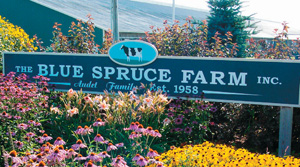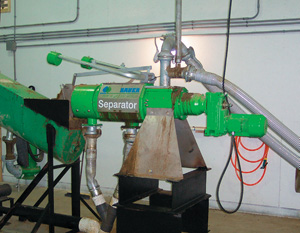
While it took some doing to
navigate the permitting process, Vermont’s Blue Spruce Dairy Farm is
finding the decision to install a biogas conversion system—which is
plugged into the grid—has provided solutions to a number of
manure-related challenges.
While it took some doing to navigate the permitting process, Vermont’s Blue Spruce Dairy Farm is finding the decision to install a biogas conversion system—which is plugged into the grid—has provided solutions to a number of manure-related challenges.

|
Farm operators should investigate the power connection permitting process and read the fine print on government grant documents before they even break ground on a power generation project.
That’s the best advice that the owners of Blue Spruce Farm, a large dairy operation in Vermont, can pass on to those considering an investment in a biogas power generating system, using manure as the feedstock and where public utility regulators and government grant money are involved.
Three brothers—Earl, Ernie, and Eugene Audet—own the 2,000-head dairy located 35 miles south of Burlington. They have just completed construction of an anaerobic digestion system and have connected its methane-fuelled power generator to the grid.
The Audets selected GHD Inc of Chilton, Wisconsin as their system supplier, and say that constructing the system from the design provided by GHD was easy to accomplish. The dairy is now at the stage of tweaking the system so that it derives the full benefit of power generation, production of dairy stall bedding with a suitable moisture content, and capturing excess heat from the generator engine to heat water and buildings in the dairy operation.
Construction began last April, and the system was capable of producing enough methane gas to begin generating power last October. However, it wasn’t until January that the dairy had overcome all the necessary regulatory hurdles to begin selling power to the grid.
“There was a lot of paperwork and a lot of hurdles at the Vermont Public Service Board to get the interconnections done,” says dairy co-owner, Earl Audet. “It took time and it was stressful, but now it’s all done, we hope.”
 The 2,000-head Blue Spruce Dairy Farm began selling power from its biogas power generating system this past January. Included in the manure handling/processing system is a Bauer separator (above), which separates the liquid stream from the solids, with the solids generated then transported to a storage building. The 2,000-head Blue Spruce Dairy Farm began selling power from its biogas power generating system this past January. Included in the manure handling/processing system is a Bauer separator (above), which separates the liquid stream from the solids, with the solids generated then transported to a storage building.
Photos by David Dunn
|
Blue Spruce Farm agreed to make the transition from spreading manure on its 2,400 acres of cropland to using it as feedstock in an anaerobic digestion process partly to take advantage of state and federal grants that were available to encourage development of alternative energy projects. The dairy owners learned the hard way that the federal government in particular has certain strict criteria that grant applicants must follow as part of the approval process. Audet says that in reality some of the grant criteria just aren’t practical, considering how few companies have experience installing this technology.
On the flip side, the dairy owners agree that using manure to generate power represents a new income stream for the farm business. Also, when the pathogen-free solid byproduct material is used for stall bedding, the dairy will save about $60,000 per year in bedding costs.
Anaerobic digestion also eliminates the odor problem associated with storing manure in an earthen lagoon or spreading it on cropland.
“The girls are now officially producing two streams of income, a milk check and a power check,” says Audet. “This is one more way to diversify the farm, improve our bottom line, and manage our manure responsibly.” He adds that the farm is also helping to raise awareness about renewable energy, but wishes there wasn’t so much red tape in the grant approval and power connection process.
The project cost $1.2 million, with Blue Spruce Farm making the largest investment. The dairy farm’s power provider, CVPS, worked with them on this project and is providing financial incentives. For example, it will collect four-cents per kilowatt hour from those consumers who choose to receive all or a portion of their power from this energy source, and will pay this amount plus 95 percent of the market price of the power to the farm generator.
Blue Spruce Farm agreed to participate in a biogas power generation project involving conversion of its manure a few years ago after being approached by CVPS. The farm is a large dairy operation, in a state where agriculture is the main industry and dairy farming among the largest sectors in that industry.
The dairy farm’s participation was a key component to the power company’s plan to develop a trademarked program called CVPS Cow Power. It is the first national program to directly link a power utility’s customers with farm power generation and the environment. “Our goal is to create a brand new market, allowing customers a renewable energy choice, and providing farmers with new income and manure management opportunities,” says CVPS program director Dave Dunn. “We’re off to a good start.”
Another area farmer who had experience operating a 22-year-old anaerobic digester suggested that Blue Spruce Farm contact GHD Inc. “After we visited one of GHD’s facilities in Wisconsin, we decided that it was the system we wanted to go with,” says Audet. The Wisconsin company provided the dairy farm with a blueprint design, and several local contractors were hired to build and connect the system’s components. This included an 800,000-gallon digester tank.
Earl Audet acted as the main contractor on the project. Subcontractors included Harrison Concrete Construction from Georgia, Vermont, Glen Peck Electric from Middlebury, Vermont, and Wild Flower Ironworks for the welding. The lawyer who helped them get all the proper permits was Eben Punderson of law firm Deppman & Foley.
GHD provided the dairy farm with the system’s key components as part of its package. It starts with two Houle piston pumps in the dairy barn that pump the manure to the digester reception pit.
From there, it is agitated with a Bauer agitator and then pumped into the digester tank using a Bauer submersible pump. The manure stays in the digester for 21 days. During that time, the manure slurry is heated and agitated at a set rate to initiate and control the digestion process. Anaerobic digestion is essentially a biological process where bacteria convert the manure into methane, carbon dioxide, and trace gases, water, and non-toxic solids.
 The methane gas from GHD’s twostage digestion vessel is transported to power Blue Spruce Farm’s Caterpillar 379G engine, which is connected to a Kato generator. The electrical switching gear to connect the generated power to the grid was provided by Martin Machinery. The methane gas from GHD’s twostage digestion vessel is transported to power Blue Spruce Farm’s Caterpillar 379G engine, which is connected to a Kato generator. The electrical switching gear to connect the generated power to the grid was provided by Martin Machinery. |
GHD’s two-stage digestion vessel produces between 55 and 70 percent methane gas, which is transported to power Blue Spruce Farm’s Caterpillar 379G engine connected to a Kato generator. The electrical switching gear to connect the generated power to the power utility was provided by an Illinois company, Martin Machinery.
After three weeks in the digestion tank, a Bauer pump removes the digested material from the tank and pumps it into a Bauer separator. It separates the liquid stream from the solids. The solids generated from the separator are transported to a storage building and are free of pathogens, weeds, and fly larvae.
When de-watered in the separator down to between 28 and 30 percent moisture content, it makes excellent dairy barn stall bedding material. The water from the separator is transported to the earthen lagoon and is safe to use to irrigate crops.
Audet says getting the solids down to that optimum moisture content is one area that is being worked on, as the dry matter is currently sitting at around 35 to 40 percent moisture content. Bauer was working to solve the problem, which was only expected to take a couple weeks.
“We’re using the bedding right now with our heifers,” says Audet. “It’s a little wetter, but it seems to be working fine.”
GHD employees also assisted during critical stages of the construction process.
 Vermont utility CVPS worked with Blue Spruce Farms on the project and is providing financial incentives. It will collect four cents per kilowatt-hour from consumers who choose to receive all or a portion of their power from this energy source, and will pay this amount plus 95 percent of the market price of the power to the farm generator. Vermont utility CVPS worked with Blue Spruce Farms on the project and is providing financial incentives. It will collect four cents per kilowatt-hour from consumers who choose to receive all or a portion of their power from this energy source, and will pay this amount plus 95 percent of the market price of the power to the farm generator. |
The company provided a three-man crew on two occasions to work on plumbing and electrical connections and to weld system components as needed. “Working with them actually helped us to understand the whole system,” Audet says.
Right now, the dairy farm is progressing through phase one of bringing the entire system on-line. For example, its generator is producing 175 kilowatts per hour, while the goal is to produce 290 kilowatts per hour. This will require installation of a turbocharger on the generator engine. However, the Audets want to ensure they can produce enough methane to provide fuel to the turbocharged engine before proceeding with this upgrade.
The owners are also developing a plan to recover excess engine heat, to heat water in the barn and the barn building itself. “If you had a house close to the engine, there is undoubtedly enough heat there to heat a house,” says Audet. “The key is to use as much of it as possible.” The excess heat may also be the possible solution to drying down the bedding material.
Once the system is fully operational, Blue Spruce Farm hopes to recover the money it has invested within seven years.
 Utility company CVPS’ Cow Power program: Customers have been lining up to support the initiative. Utility company CVPS’ Cow Power program: Customers have been lining up to support the initiative. |
A number of area dairy farmers have shown an interest in the anaerobic digestion project at Blue Spruce Farm and are eager to see how successful the project is. Audet says because the project has just been completed, it is still too early to say whether it has been worthwhile. In the meantime, CVPS is already lining up customers wanting to support the Cow Power initiative. So far, the utility says more than 1,000 CVPS customers have signed up to purchase Cow Power energy, with dozens more enrolling each week. About half have enrolled for 25 percent Cow Power, with the remainder split between 50 percent and 100 percent.
“Many of our customers want to vote for renewable energy with their wallets,” says CVPS spokesperson, Steve Costello. “Support of farmers, the environment, and renewable energy are key factors. People seem to like that it’s local, it’s practical, and it’s benefiting people who work the land and is helping to keep Vermont looking like Vermont.”